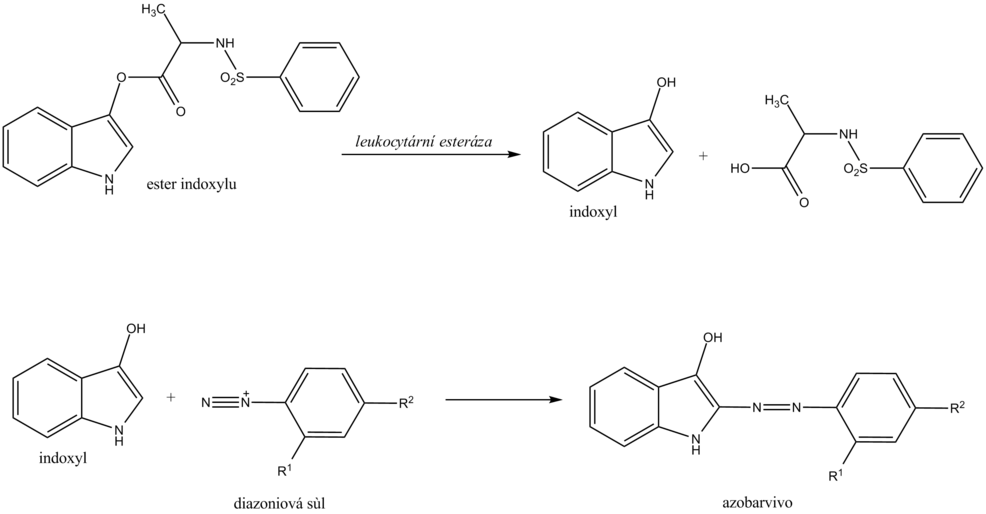Determination of leukocytes in urine: Difference between revisions
No edit summary |
No edit summary |
||
| Line 1: | Line 1: | ||
Chemical determination of leukocytes with a diagnostic strip is based on the detection of '''esterases''' that are abundant in granulocytes . Granulocyte esterases catalyze the hydrolysis '''of indoxyl ester''' to free indoxyl. The indoxyl then reacts with the stable diazonium salt to form the appropriate azo dye. In the case of a negative reaction, the zone turns cream yellow; in the case of a positive reaction, it changes to a pink to purple hue. | Chemical determination of leukocytes with a diagnostic strip is based on the detection of '''esterases''' that are abundant in [[wikiskripta:Granulocyty|granulocytes]] . Granulocyte esterases catalyze the hydrolysis '''of indoxyl ester''' to free indoxyl. The indoxyl then reacts with the stable diazonium salt to form the appropriate azo dye. In the case of a negative reaction, the zone turns cream yellow; in the case of a positive reaction, it changes to a pink to purple hue. | ||
[[File:Leukocytární esteráza.png|thumb|986x986px]] | [[File:Leukocytární esteráza.png|thumb|986x986px]] | ||
Leukocyturia is a symptom of inflammation of the kidneys or urinary tract. The cause of most positive findings is a bacterial infection of the urinary tract . In case of a positive leukocyte finding, it is recommended to supplement the examination of proteinuria , hematuria , nitrituria , examination of urinary sediment and further microbiological examination . | Chemical examination of leukocytes does not replace [[wikiskripta:Vyšetření_močového_sedimentu#leukocyty|microscopic examination]] . On the other hand, it is possible to detect lysed [[wikiskripta:Leukocyt|leukocytes]] (eg in hypotonic [[wikiskripta:Vyšetření_močového_sedimentu|urine]] ) in this way, which is not possible with microscopic examination. | ||
Leukocyturia is a symptom of inflammation of the kidneys or urinary tract. The cause of most positive findings is a [[wikiskripta:Infekce_močových_cest|bacterial infection of the urinary tract]] . In case of a positive leukocyte finding, it is recommended to supplement the examination of [[wikiskripta:Proteinurie|proteinuria]] , [[hematuria]] , [[wikiskripta:Nitriturie|nitrituria]] , [[wikiskripta:Vyšetření_močového_sedimentu|examination of urinary sediment]] and further microbiological examination . | |||
Revision as of 19:47, 6 April 2022
Chemical determination of leukocytes with a diagnostic strip is based on the detection of esterases that are abundant in granulocytes . Granulocyte esterases catalyze the hydrolysis of indoxyl ester to free indoxyl. The indoxyl then reacts with the stable diazonium salt to form the appropriate azo dye. In the case of a negative reaction, the zone turns cream yellow; in the case of a positive reaction, it changes to a pink to purple hue.
Chemical examination of leukocytes does not replace microscopic examination . On the other hand, it is possible to detect lysed leukocytes (eg in hypotonic urine ) in this way, which is not possible with microscopic examination.
Leukocyturia is a symptom of inflammation of the kidneys or urinary tract. The cause of most positive findings is a bacterial infection of the urinary tract . In case of a positive leukocyte finding, it is recommended to supplement the examination of proteinuria , hematuria , nitrituria , examination of urinary sediment and further microbiological examination .



